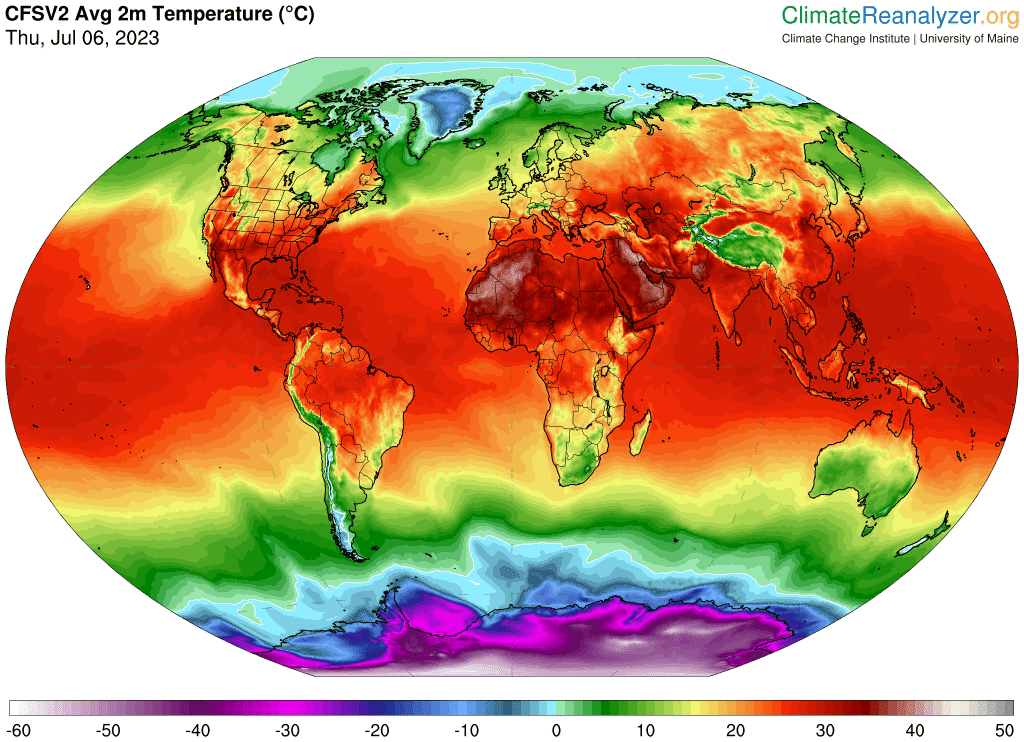It’s time to start taking the climate crisis more seriously. On Wednesday, the world’s average temperature reached its highest level since records began – a record previously broken on Monday and Tuesday this week. The global average temperature climbed to 17.23 degrees Celsius, according to the University of Maine Climate Reanalyzer, a tool widely used by climate scientists.

Climate scientists attributed the temperature record to greenhouse gas emissions pushing global temperatures up, the start of the summer in the northern hemisphere and the return of the El Niño climate phenomenon. They warned further records could continue to be broken in the next months due to a combination of the same factors.
The Climate Reanalyzer, run by the University of Maine, evaluates the average global temperature through surface, air balloon and satellite observations, along with computer modelling. While the readings obtained aren’t considered an official government record, they are highly regarded and considered a reliable source.
Global average temperatures reached 17.01 degrees Celsius on Monday and 17.18 degrees Celcius on Tuesday. Before that, the previous record was 16.92 degrees Celsius, set on August 14th 2022. Friederike Otto, a climate scientist, told BBC this should be a wake-up call “for anyone who thinks the world needs more oil and gas”.
“Monday, July 3rd was the hottest day ever recorded on Planet Earth. A record that lasted until … Tuesday, July 4th,” Bill McGuire, a climate hazards researcher, wrote on Twitter. But Wednesday proved even hotter, and we’re not even halfway through summer.
Record weather
Temperatures exhibit significant variation across the planet, particularly on land, both geographically and seasonally. Warmer temperatures tend to prevail nearer to the tropics, while colder temperatures dominate the polar regions. Scientists rely on global average temperatures to get valuable insight into the dynamic changes on Earth.
“Global warming is leading us into an unfamiliar world,” Robert Rohde, lead scientist at the environmental data analysis group Berkeley Earth, wrote on Twitter. He said while the Reanalyzer only goes back to 1979, other data sets that allow to go further back “conclude this day was warmer” than any point since instrumental records began.
The record is partly explained by climate change causing the world to warm, with global temperatures having already increased 1.25 Celsius above the preindustrial average. In fact, UN climate experts warned last year that the planet was on track to exceed the agreed global target of keeping global warming to 1.5 degrees Celsius.
But that’s not the only reason. The World Meteorological Organization (WMO) already declared the return of El Niño, a naturally occurring climate pattern that happens every two to seven years. El Niño could lead to a further increase in global temperatures and extreme weather conditions, making it even more likely for the world to reach 1.5.
“The onset of El Nino will greatly increase the likelihood of breaking temperature records and triggering more extreme heat in many parts of the world and in the ocean,” WMO secretary-general Petteri Taalas said in a statement, calling governments to “mobilize preparations” to limit the impacts on ecosystems, health and economies.
The news follows a series of extreme weather events across the planet in recent months. China registered this week the highest number of hot days over six months since records began. Spain and Portugal recorded their hottest April temperatures amid a heat wave. And Mexico and the southern US saw 14 deaths due to record temperatures.









